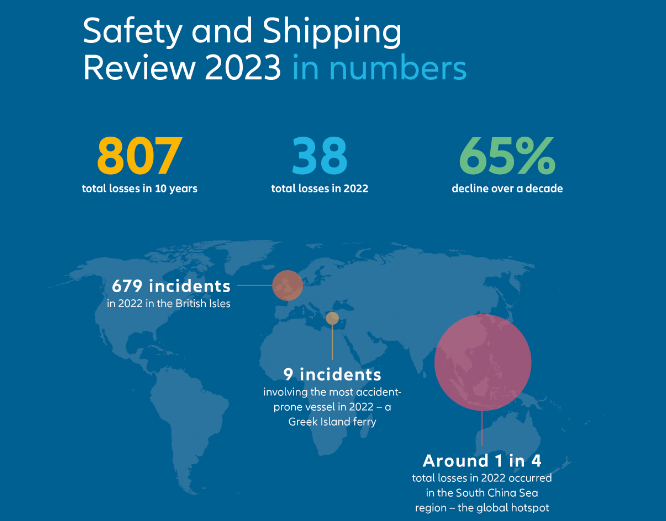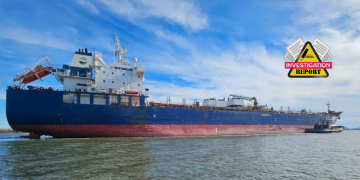Allianz Global Corporate & Specialty (AGCS) has issued this year’s Safety and Shipping Review report, identifying a number of risk challenges for the maritime sector. The report highlights that fire is the second top cause of loss over the past year with 8 vessels lost and more than 200 incidents reported – the highest for a decade. In addition, transport of electric vehicles and battery-powered goods bring new fire risks while larger vessels and misdeclaration of cargo amplify consequences.
Shipping transports between 80% to 90% of world trade onboard different vessels so maritime safety is critical. Improvements have been significant over the past decade in particular. Thirty years ago, the global fleet was losing 200+ vessels a year. At the end of 2022 fewer than 40 losses were reported. It has now been six years since a triple‑digit total loss year.
Covid-19 pandemic
Following the post-pandemic boom in container shipping, economic and geopolitical uncertainty and falling demand have hit freight rates. The cost of shipping a container between Asia and the United States or Europe in April 2023 was more than 80% lower than a year earlier.
The question is whether this decline, together with the prospect of an economic downturn, will impact maintenance and risk management budgets. Prior downturns have impacted these, leading to losses and an uptick in machinery damage incidents.
… notes Justus Heinrich, Global Product Leader Marine Hull at AGCS
Dark fleet
More than a year after Russia’s invasion of Ukraine, the growth of the shadow oil tanker fleet is the latest consequence to challenge shipowners, their crew and insurers.
… said Captain Rahul Khanna, Global Head of Marine Risk Consulting at AGCS
The threat of collateral damage on civilian shipping in or around the war risk area remains high and could stem from floating mines for example.
The shadow fleet is more likely to be made up of older ships, operating under flags of convenience with lower maintenance standards
… said Justus Heinrich, Global Product Leader Marine Hull at AGCS
Oil sanctions have also resulted in Russia and its allies creating a shadow tanker fleet to transport and sell its oil. Estimates of its size vary – as many as 600 vessels.
Decarbonization
Transitioning away from carbon-based shipping will involve a demanding period of change and significant investment of about $1.4trn. A mix of fuels is likely to exist for the next five to 10 years, posing challenges for shipowners, operators and ports. From a loss perspective the industry has not yet seen any major claims from alternative technologies or fuels.
Collaboration is key and regular exchanges of information and data between companies and insurers from testing and experiences will be important in helping to reduce transition risks
… stated Justus Heinrich
Factors impacting the cost of claims
Increased commodity prices, higher labor costs and supply chain disruption have had a significant impact on marine insurance claims, in particular hull and machinery.
Shortages and delays in obtaining replacement parts have also led to longer stays in repair yards while labor shortages have also increased costs. This comes on top of the increased expense of dealing with large vessels, which face higher costs for repairs, salvage and towing.
… explained Régis Broudin, Global Head of Marine Claims at AGCS
Shipping losses
The review shows 38 total losses of vessels (over 100 gross tonnage [GT]) during 2022, compared with 59 a year earlier, down by 36%. Annual shipping losses have declined by 65% over the past decade (109 total losses in 2013) reflecting the positive effect of an increased focus on safety measures over time, such as regulation, improved ship design and technology and risk management advances.
While total losses declined over the past year, the number of shipping casualties or incidents reported remained consistent (3,032 compared to 3,000 a year earlier)

Regions with most incidents
The British Isles saw the highest number of incidents (679) while machinery damage/failure accounted for close to half of all incidents globally (1,478). There were over 200 fires reported during 2022 (209) – the highest for a decade, making this the third top cause of incidents with activity up 17% year‑on‑year.
South China, Indochina, Indonesia and the Philippines is the global loss hotspot, both over the past year and decade (204 total losses). It accounted for one in four losses in 2022 (10), driven by factors such as high levels of trade, congested ports, older fleets and extreme weather.
The Arabian Gulf, British Isles, and West Mediterranean waters were the second top loss locations (3). The past 10 years have seen 807 total losses reported. Three regions, South China, Indochina, Indonesia and the Philippines, East Mediterranean and Black Sea (118), and Japan, Korea and North China (76) account for almost 50% of global loss activity over this time.
The East Mediterranean and Black Sea region has seen the most shipping incidents over the past decade (4,969). Globally, most of the 27,477 incidents reported over the past decade have been caused by machinery damage/failure (10,753), followed by collision (3,098) and wrecked/stranded (2,936).

Vessel types
Around a quarter of vessels lost in 2022 were cargo (10). Together, fishing (6) and passenger (5) vessels also accounted for a quarter of the total. Foundered (sunk/submerged) was the main cause of total loss across all vessel types (20), accounting for over 50%.
Contributing factors included bad weather, poor visibility, flooding and machinery breakdown. Fire/explosion ranked as the second top cause of loss (8). Vessel collision ranked third (4). Extreme weather was reported as a factor in at least 8 losses during 2022, while January was the most frequent month for losses with 6.






























































I found a lot of interesting statistics in this publication/ Thanks for a good work